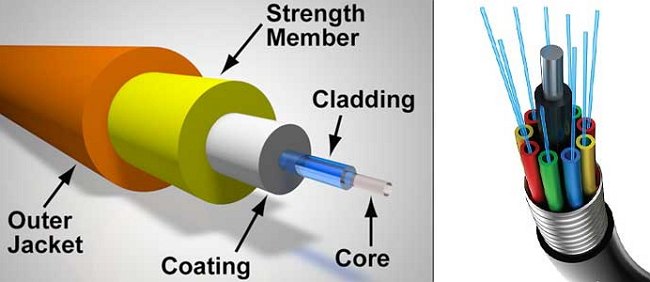sumber:https://www.dataglobal.co.id/pengertian-fiber-optic/
Advantages and Disadvantages of Fiber Optic
Although it comes with more capabilities than the previous type of cable, it does not mean that this Fiber Optic cable does not have any drawbacks at all. Below we explain the various advantages and disadvantages that you can get when using Fiber Optics:
Advantages of Fiber Optic
- This type of Fiber Optic cable has the ability to deliver data with large capacities and very long transmission distances. With a capacity of Gigabytes per second, it gives internet and telephone companies the freedom to choose high bandwidth.
-
Despite having great capabilities, the physical form of this cable is smaller when compared to other types because the material is made of glass fiber and plastic. This allows the availability of large enough space.
-
Despite having great capabilities, the physical form of this cable is smaller when compared to other types because the material is made of glass fiber and plastic. This allows the availability of large enough space.
-
Even though it has a high access speed, the possibility of data loss is very low, so you don’t have to worry about data validity.
-
Because it does not use electricity, the possibility of a short circuit will also not occur, so in terms of security it is also very guaranteed.
Disadvantages of Fiber Optic
- The biggest drawback of Fiber Optic cables is that the price is quite high, this is very reasonable considering the materials used and the installation. Therefore, users of this type of cable are not arbitrary, but companies or communication service providers who really want faster access.
-
In addition to being expensive at the time of installation, Fiber Optic maintenance also costs a lot of money considering the tools used are also not cheap.
-
Also pay attention to the placement of Fiber Optic cables, usually installed on bends or those that have curved corners so that the wave process can run more smoothly or not be hampered.
How Fiber Optic Works
Previously, it was explained that Fiber Optic cables do not conduct electricity but light. The electricity obtained is converted into light signals and passed between computers connected in a large-scale network. This makes Fiber Optic cables very suitable for use in areas with a lot of electromagnetic interference. If in Coaxial or Twisted cables, the length of the cable is often an obstacle, but this does not apply to Fiber Optic cables. Raw materials made of pure glass fiber are able to carry light to transmit data continuously regardless of the length of the cable used. The point is in the Fiber Optic cable using a working method by utilizing a mirror to produce a total internal reflection or the general language is a total reflection on the glass fiber part.

Komentar Terbaru